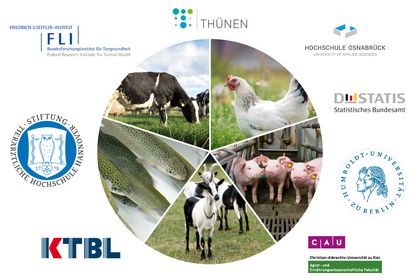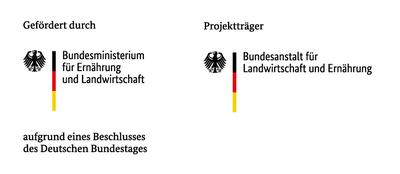Monitoring Animal Welfare in Agriculture and Fish Farming. The Project “National Animal Welfare Monitoring” (NaTiMon)
The following project-reports are available in english:
Recommendations for the introduction of a national animal welfare monitoring system in Germany
- Although animal welfare is important to the German citizens, adequate information is still missing
- The implementation of a national animal welfare monitoring would help to solve the issue
- NaTiMon selected suitable indicators and developed an evidence-based concept for the implementation of a national animal welfare monitoring in Germany
Animal Welfare in husbandry is a topic of high relevance to German citizens. In the most recent Eurobarometer survey, 92% of the interviewed persons answered the question ‘How important is it to protect the welfare of farmed animals?’ with ‘important’.
In 2023, German farmers reared 11 million cattle, 43 million pigs, 1,6 million sheep, 630 million chicken and 31 million turkeys. Yet, due to missing information, it is neither possible to describe the status quo nor the developments of animal welfare. The lack of data on animal welfare indicators (e.g. mortality, lameness, foot pad lesions) prevents policy from designing relevant animal welfare strategies and makes it difficult to evaluate the effectiveness of existing animal welfare legislation and support measures.
The NaTiMon project consortium
In the German ‘National Animal Welfare Monitoring’ (NaTiMon) project, a consortium of 10 institutions developed a concept for a regular and systematic measurement of animal welfare in livestock farming at a national level. With the involvement of stakeholders, suitable indicators were selected, possibilities for the use of existing data identified and procedures for the collection of missing data developed. Indicators for husbandry, transport and slaughter of cattle, pigs, chickens, turkeys, sheep, goats and of rainbow trout and carp from aquaculture were included, as well as context-indicators describing conditions of livestock farming.
Recommendations
The following steps are recommended for the implementation of a future national animal welfare monitoring system:
- Create a legal basis
To access and evaluate existing data and to collect data on farms, fish farms, control posts, at slaughter houses and rendering facilities, a new legislation is needed. - Provide institutional basis and infrastructure
The monitoring can be implemented by the statistical offices (implementation of the sampling for all surveys and realisation of written surveys), federal research institutes (coordination, planning, data analysis, reporting) and certification bodies (audits). - Provide funds for implementation
The collection of data, data processing, evaluation and publication are associated with costs. Annual costs of 1.9 Mio. Euro have been estimated for audits and 0.9 Mio. Euro for the tasks to be carried out by the federal research institutes. - Enable the use of existing data
To avoid duplicate surveys, existing information should be used for a national animal welfare monitoring. This requires the combination of different data sources as well as disaggregation and improvements in data quality of selected data. - Implement the collection of missing data
For the majority of relevant animal welfare indicators, data are not yet available. In order to implement an animal welfare monitoring, these data need to be collected through audits (for animal-based indicators) and in the form of written surveys. - Publish an animal welfare monitoring report
To inform all interested groups about the status quo and the development of animal welfare, the results of the national animal welfare monitoring should be published in the form of reports and on a website.
Significance of the project at the European level
Animal welfare in livestock farming is an issue relevant to citizens in all countries of the European Union. In the mentioned Eurobarometer survey from 2023, 93% of the interviewed citizens answered the question ‘How important is it to protect the welfare of farmed animals?’ with ‘important’.
Just as in Germany, there is also a lack of information on animal welfare across the European Union. The NaTiMon approach cannot be scaled up to EU-level without consideration of existing differences in the monitoring programmes between member states. Each member state has its own system of data collection and data recording. In addition, structures of farming and processing differ. On the other hand, common features exist: e.g., each member state has a milk recording system, official veterinarians are present at ante- and post-mortem inspection and all countries have organisations which can perform animal welfare audits, in order to record animal-welfare data that has yet to be collected.
Therefore, the project-results can provide input to the process of implementing a pan-European animal welfare monitoring system. The steps recommended for the implementation of a future animal welfare monitoring system in Germany also hold for the European-level.


